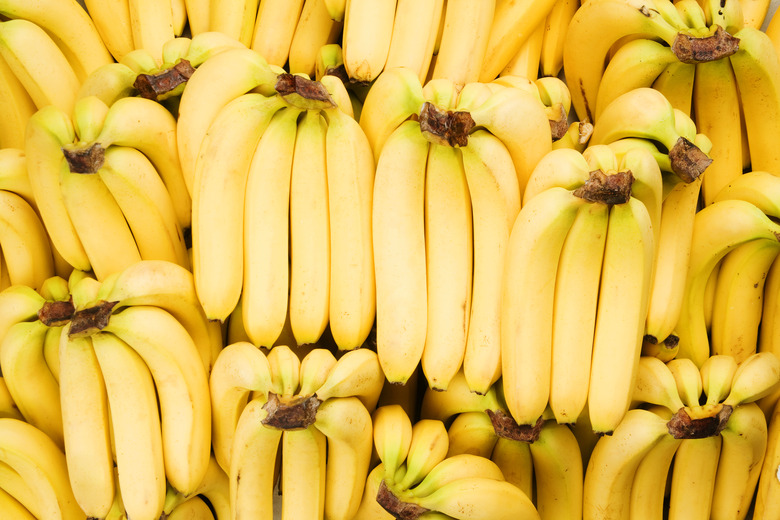How To Use A Banana Peel As Plant Food
We may receive a commission on purchases made from links.
Although you certainly wouldn't want to eat a banana peel, throwing it away means discarding lots of useful nutrients. Instead, consider using the banana peel to create a natural fertilizer for your plants.
Some ways you can use banana peels as fertilizer for your plants are:
- Water your plants with a compost banana peel tea
- Spread dried banana peels in your garden
- Ferment banana peels and sprinkle them around your plants
- Douse acid-loving plants with a banana vinegar mixture
- Bury banana peels in the garden
Whatever method you choose, there are compelling reasons to give banana peel fertilizers a chance. Banana peels are high in potassium, which helps plants develop strong and healthy roots. The phosphorous in banana peels does the same while also helping the plant produce flowers, fruit and pollen. Magnesium helps make photosynthesis easier, and calcium improves the circulation of soil nutrients throughout the entire plant. By turning your banana peels into fertilizer, you can get all of these benefits out of something you would ordinarily throw away.
Warning
A word of caution is in order, particularly for people sensitive to wasp and bee stings. Bananas contain a compound (isopentyl acetate) that resembles a pheromone released by honeybees when they feel threatened, which compels them to enter fight/attack mode. Exercise caution when using banana products as fertilizer in the garden.
How to Make Banana Peel Tea
How to Make Banana Peel Tea
To fertilize your plants, you can use your banana peels to make a solution similar to compost tea. Doing so is a simple process that uses water and time to leach nutrients out of the banana peel and into the water. You can then simply water your garden as you normally would with your tea. When you're done making the tea, you can bury the banana peels in the garden, allowing you to get the maximum amount of benefits from your saved peels.
Here's how to make a compost tea with banana peels:
- Fill a mason jar with water and drop a banana peel into it.
- Close the jar and let it sit on the counter for two days.
- Pluck the banana peel out of the jar and set it aside. Then, use the water in the jar to water your plants.
- Cut the banana peel into 1/4-inch pieces and bury them in the garden next to your plants. Place them about 4 inches deep.
How to Make Dried Banana Peel Fertilizer
How to Make Dried Banana Peel Fertilizer
If you prefer, you can dry your banana peels and grind them into a fertilizing powder. When it's ready, you can easily spread your powder around your garden to add nutrients to the soil. You can also mix powdered banana peel fertilizer into your potting soil to feed indoor plants.
- Cut your banana peels lengthwise into 1/4-inch strips. Arrange the strips on a cookie sheet so they are not touching or overlapping.
- Place the cookie sheet in an oven heated to 140 degrees Fahrenheit. Leave the oven door cracked open 1 or 2 inches and cook the peels until they're completely dried. You can also used a food dehydrator to dry the peels.
- When they've cooled, use a coffee grinder or food processor to grind them into a powder.
- Sprinkle the powder around your plants to fertilize them.
How to Ferment Banana Peels for Fertilizer
How to Ferment Banana Peels for Fertilizer
Fermenting your banana peels is a good way to give your plants a boost, but it can be tricky. The process takes several days, and if it goes wrong, it will produce a moldy mess that you can't use. It costs nothing to give it a try, however, and the resulting fertilizer is excellent for flowering plants, including roses (Rosa spp.).
- Place your banana peel in a mason jar.
- Fill the jar with just enough water to cover the banana peels. If they start to float, stuff something heavy in the jar to keep them submerged.
- Cover the jar with a piece of cloth and secure it with a rubber band.
- Let the jar sit for a week. It's okay if the water gets cloudy, but throw it away if you see mold.
- After a week, strain the water in the jar and fertilize your plants with it. Then, drop your fermented banana peels into the blender and puree them.
- Side dress your flowering plants with the banana peel puree and then work it into the soil to a depth of about 4 inches. Working the mixture into the soil prevents the banana from attracting unwanted critters to your yard.
How to Make Banana Peel Fertilizer for Acid Lovers
How to Make Banana Peel Fertilizer for Acid Lovers
Plants like azaleas (Rhododendron spp.) and blueberries (Vaccinium spp.) love both acidic soil and fertilizer. You can give them both by turning your banana peels into an acid- and nutrient-rich vinegar. The process takes a few weeks, but it's super easy.
- Ferment your banana peels for a week.
- When the week is over, remove the banana peels from the jar but leave the water. Replace the cloth cover on the jar after retrieving your peels.
- Leave the water in the jar alone for four to six weeks, giving it time to keep fermenting until it turns into vinegar.
- Smell the vinegar. When it has that recognizable vinegar smell, it's time to water your acid-loving plants with it. The mixture should smell like vinegar, but it shouldn't knock your socks off. If your vinegar smells especially potent, dilute it in some water before using it to fertilize your plants so you don't accidentally burn their roots.
